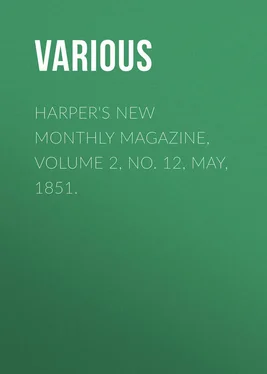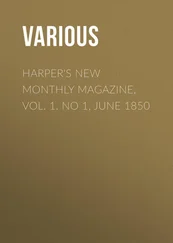Various - Harper's New Monthly Magazine, Volume 2, No. 12, May, 1851.
Здесь есть возможность читать онлайн «Various - Harper's New Monthly Magazine, Volume 2, No. 12, May, 1851.» — ознакомительный отрывок электронной книги совершенно бесплатно, а после прочтения отрывка купить полную версию. В некоторых случаях можно слушать аудио, скачать через торрент в формате fb2 и присутствует краткое содержание. Издательство: Иностранный паблик, Жанр: periodic, foreign_edu, на английском языке. Описание произведения, (предисловие) а так же отзывы посетителей доступны на портале библиотеки ЛибКат.
- Название:Harper's New Monthly Magazine, Volume 2, No. 12, May, 1851.
- Автор:
- Издательство:Иностранный паблик
- Жанр:
- Год:неизвестен
- ISBN:нет данных
- Рейтинг книги:3 / 5. Голосов: 1
-
Избранное:Добавить в избранное
- Отзывы:
-
Ваша оценка:
- 60
- 1
- 2
- 3
- 4
- 5
Harper's New Monthly Magazine, Volume 2, No. 12, May, 1851.: краткое содержание, описание и аннотация
Предлагаем к чтению аннотацию, описание, краткое содержание или предисловие (зависит от того, что написал сам автор книги «Harper's New Monthly Magazine, Volume 2, No. 12, May, 1851.»). Если вы не нашли необходимую информацию о книге — напишите в комментариях, мы постараемся отыскать её.
Harper's New Monthly Magazine, Volume 2, No. 12, May, 1851. — читать онлайн ознакомительный отрывок
Ниже представлен текст книги, разбитый по страницам. Система сохранения места последней прочитанной страницы, позволяет с удобством читать онлайн бесплатно книгу «Harper's New Monthly Magazine, Volume 2, No. 12, May, 1851.», без необходимости каждый раз заново искать на чём Вы остановились. Поставьте закладку, и сможете в любой момент перейти на страницу, на которой закончили чтение.
Интервал:
Закладка:
Various
Harper's New Monthly Magazine, Volume 2, No. 12, May, 1851
THE NOVELTY WORKS, WITH SOME DESCRIPTION OF THE MACHINERY AND THE PROCESSES EMPLOYED IN THE CONSTRUCTION OF MARINE STEAM-ENGINES OF THE LARGEST CLASS
Perhaps no one of those vast movements which are now going forward among mankind, and which mark so strikingly the industrial power and genius of the present age, is watched with more earnest interest by thinking men, than the successive steps of the progress by which the mechanical power of steam and machinery is gradually advancing, in its contest for the dominion of the seas. There is a double interest in this conflict. In fact, the conflict itself is a double one. There is first a struggle between the mechanical power and ingenuity of man, on the one hand, and the uncontrollable and remorseless violence of ocean storms on the other; and, secondly, there is the rivalry, not unfriendly, though extremely ardent and keen, between the two most powerful commercial nations on the globe, each eager to be the first to conquer the common foe.
The armories in which the ordnance and ammunition for this warfare are prepared, consist, so far as this country is concerned, of certain establishments, vast in their extent and capacity, though unpretending in external appearance, which are situated in the upper part of the city of New York, on the shores of the East River. As the city of New York is sustained almost entirely by its commerce, and as this commerce is becoming every year more and more dependent for its prosperity and progress upon the power of the enormous engines by which its most important functions are now performed, the establishments where these engines are invented and made, and fitted into the ships which they are destined to propel, constitute really the heart of the metropolis; though, the visitor, who comes down for the first time by the East River, from the Sound, in the morning boat from Norwich or Fall River, is very prone to pass them carelessly by – his thoughts intent upon what he considers the superior glory and brilliancy which emanate from the hotels and theatres of Broadway.
In fact, there is very little to attract the eye of the unthinking traveler to these establishments as he glides swiftly by them in the early morning. He is astonished perhaps at the multitude of steamers which he sees lining the shores in this part of the city, some drawn up into the docks for repairs; others new, and moored alongside a pier to receive their machinery; and others still upon the stocks in the capacious ship-yards, in the various stages of that skeleton condition which in the ship marks the commencement, as in animal life it does the end, of existence. Beyond and above the masts and spars and smoke-pipes of this mass of shipping, the observer sees here and there a columnar chimney, or the arms of a monstrous derrick or crane, or a steam-pipe ejecting vapor in successive puffs with the regularity of an animal pulsation. He little thinks that these are the beatings which mark the spot where the true heart of the great metropolis really lies. But it is actually so. The splendor and the fashion of the Fifth Avenue, and of Union-square, as well as the brilliancy, and the ceaseless movement and din of Broadway, are the mere incidents and ornaments of the structure, while these establishments, and others of kindred character and function, form the foundation on which the whole of the vast edifice reposes.
We select, rather by accident than otherwise, the Novelty Works as a specimen of the establishments to which we have been alluding, for description in this Number. A general view of the works as they appear from the river, is presented in the engraving at the head of this article, with the docks and piers belonging to the establishment in the fore-ground.
The entrance to the inclosure is by a great gateway, through which the visitor on approaching it, will, very probably see an enormous truck or car issuing, drawn by a long team of horses, and bearing some ponderous piece of machinery suspended beneath it by means of levers and chains. On the right of the entrance gate is the porter's lodge, with entrances from it to the offices, as represented in the plan on the adjoining page Beyond the entrance, and just within the inclosure may be seen a great crane used for receiving or delivering the vast masses of metal, the shafts, the cylinders, the boilers, the vacuum pans, and other ponderous formations which are continually coming and going to and from the yard. Beyond the crane is seen the bell by which the hours of work are regulated.
The plan upon the adjoining page will give the reader some idea of the extent of the accommodations required for the manufacture of such heavy and massive machinery. On the right of the entrance may be seen the porter's lodge, shown in perspective in the view below. Beyond it, in the yard, stands the crane, which is seen likewise in the view. Turning to the left, just beyond the crane, the visitor enters the iron foundry, a spacious inclosure, with ovens and furnaces along the sides, and enormous cranes swinging in various directions in the centre. These cranes are for hoisting the heavy castings out of the pits in which they are formed. The parts marked v v v, are ovens for drying the moulds.
Turning to the right from the foundry, and passing down through the yard, the visitor finds himself in the midst of a complicated maze of buildings, which extend in long ranges toward the water, with lanes and passages between them like the streets of a town. In these passages companies of workmen are seen, some going to and fro, drawing heavy masses of machinery upon iron trucks; others employed in hoisting some ponderous cylinder or shaft by a crane, or stacking pigs of iron in great heaps, to be ready for the furnaces which are roaring near as if eager to devour them. And all the time there issues from the open doors of the great boiler-shops and forging-shops below, an incessant clangor, produced by the blows of the sledges upon the rivets of the boilers, or of the trip-hammers at the forges.
The relative positions of the various shops where the different operations are performed will be seen by examination of the plan. The motive power by which all the machinery of the establishment is driven, is furnished by a stationary engine in the very centre of the works, represented in the plan. It stands between two of the principal shops. On the right is seen the boiler, and on the left the engine – while the black square below, just within the great boiler-shop, represents the chimney. Other similar squares in different parts of the plan represent chimneys also, in the different parts of the establishment. These chimneys may be seen in perspective in the general view, at the head of this article, and may be identified with their several representations in the plan, by a careful comparison. The one belonging to the engine is the central one in the picture as well as in the plan – that is, the one from which the heaviest volume of smoke is issuing.
This central engine, since it carries all the machinery of the works, by means of which every thing is formed and fashioned, is the life and soul of the establishment – the mother , in fact, of all the monsters which issue from it; and it is impossible to look upon her, as she toils on industriously in her daily duty, and think of her Titanic progeny, scattered now over every ocean on the globe, without a certain feeling of respect and even of admiration.
A careful inspection of the plan will give the reader some ideas of the nature of the functions performed in these establishments, and of the general arrangements adopted in them. The magnitude and extent of them is shown by this fact, that the number of men employed at the Novelty Works is from one thousand to twelve hundred. These are all men , in the full vigor of life. If now we add to this number a proper estimate for the families of these men, and for the mechanics and artisans who supply their daily wants, all of whom reside in the streets surrounding the works, we shall find that the establishment represents, at a moderate calculation, a population of ten thousand souls .
Читать дальшеИнтервал:
Закладка:
Похожие книги на «Harper's New Monthly Magazine, Volume 2, No. 12, May, 1851.»
Представляем Вашему вниманию похожие книги на «Harper's New Monthly Magazine, Volume 2, No. 12, May, 1851.» списком для выбора. Мы отобрали схожую по названию и смыслу литературу в надежде предоставить читателям больше вариантов отыскать новые, интересные, ещё непрочитанные произведения.
Обсуждение, отзывы о книге «Harper's New Monthly Magazine, Volume 2, No. 12, May, 1851.» и просто собственные мнения читателей. Оставьте ваши комментарии, напишите, что Вы думаете о произведении, его смысле или главных героях. Укажите что конкретно понравилось, а что нет, и почему Вы так считаете.












